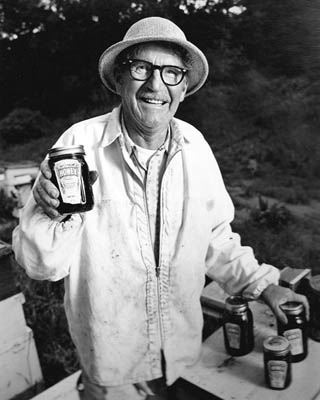Karl “Papa Bee” Wollarth 1913-2007

I first noticed him while standing in the checkout line at the Sunburst market on Milpas Street in the early ’80s. He had some weathered overalls on, held up by colorful suspenders, and atop his lightly grizzled head sat a pith helmet. He was bantering with the checkout girl about healthy living in a wonderfully insouciant, humorous way. With a kind of folksy, Walter Brennan cadence to his speech, he stood out. He was one of those characters who enrich the human landscape.
Karl Wollarth, or “Papa Bee” to those who knew him, was a fixture in Santa Barbara for more than 50 years. He was a beekeeper, an organic farmer (or “experimental soil conditioner” as he called himself), and an educator about natural ecology. His soil research, applied to his farming, produced results that were called “astounding and revolutionary” by local environmentalists.
He and his wife, Erna, lived in a house on a piece of land near La Cumbre. It was a Garden of Eden, with every kind of fruit tree and vegetable imaginable, plus lots of chickens and geese running around amidst the thick berry patches. Papa Bee and Erna sold honey at the weekend swap meets, so there was an abundance of bees in the garden as well. The land originally comprised a thin layer of soil and Zaca clay, but through enriching their soil with organic materials, mulch, and some iron sulfate or ammonium sulfate here and there, irrigating it just right, and encouraging the proper balance of bugs and birds, Karl and Erna managed to create a veritable Fertile Crescent.
Karl told me that a commercial pilot once knocked on his door and asked to see the garden. He told Karl that his exceptionally lush and verdant jungle stood out from the air as a rare anomaly even amongst the green landscape of Santa Barbara. He said he just had to drop by and check it out from the ground. Karl welcomed him. He never tired of showing his city garden or conducting herb walks through the foothills to educate people about the medicinal gifts there for the taking: horsetail, mugwort, and stinging nettle. He’d generously offer his vast knowledge to anyone at any time while never losing the desire to learn himself.
My good fortune was to be able to serve with him while running the Santa Barbara Cancer Victors and Friends chapter for many years and to hear him at monthly meetings sharing his vast knowledge of natural medicine, often educating even “the expert speaker” of the evening. Karl told me he had suffered from poor health as a young man. He recovered by becoming his own doctor. Among his innovations, he developed a magnesium chloride compound that he used topically to get rid of some melanomas he’d developed from too much time in the sun.
His imagination never stopped. One minute he’d try to persuade the city to plant fruit trees instead of ornamental varieties so less fortunate people would have free food. The next minute he’d propose creating huge holes in the mountains between the San Fernando Valley and the Pacific Ocean so giant fans could blow all the smog out to sea. He also offered the engineering details on how to do it. A local paper once featured the design of a low-cost trap Karl invented to capture yellowjackets that were mingling with his honeybees. Those of us who spent any time with him recognized we were hanging around with some sort of genius.
He often dropped in on my family and was a real teacher for our young, homeschooled children. Later, our daughter Lily chose him as a subject for her college admissions essay. She wrote: “He brought my Mom a jar of black avocado honey to rub into her wrinkles and planted himself in our lives in a way that will never be eradicated. He came into our kitchen, a Saint Francis of Assisi with bees instead of birds. He gently swiped at the air above his pith helmet to ‘shoo’ his little yellow-and-black robed followers outside, the way other people might wipe their feet. To us kids, he was at least five hundred years old in wisdom, but he was in really good shape. My brother Andy and I watched in awe as he talked of golden raspberries and gopher weed while a stowaway bee crawled out of his ear, across his cheek, and into his nostril. He appeared not to notice. We deified him, right then and there.”
So many of us did. A memorial service will be held Saturday, January 5, at 2 p.m. at the Seventh-day Adventist Church, 425 Arroyo Road.



